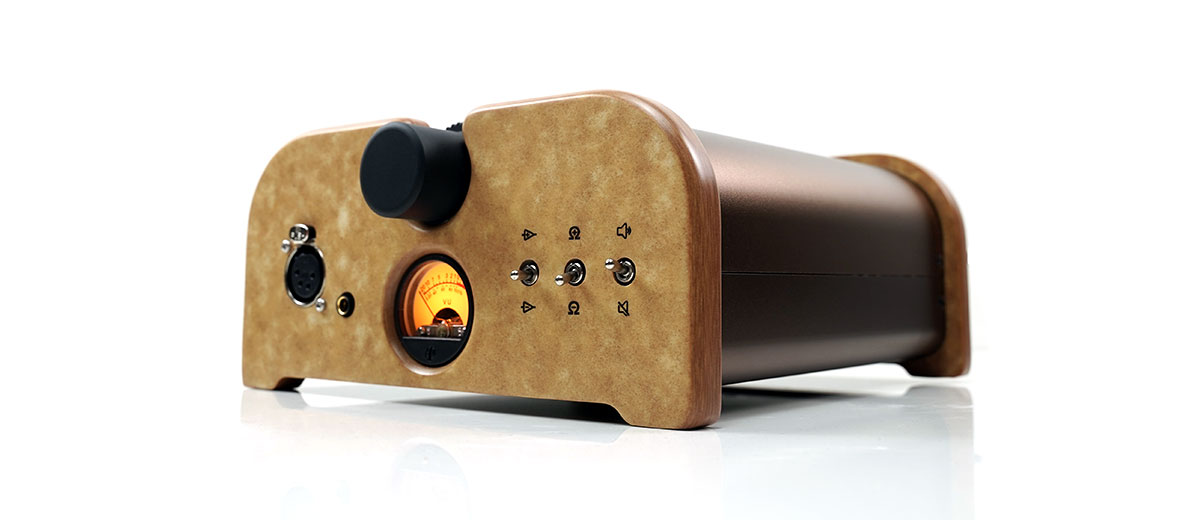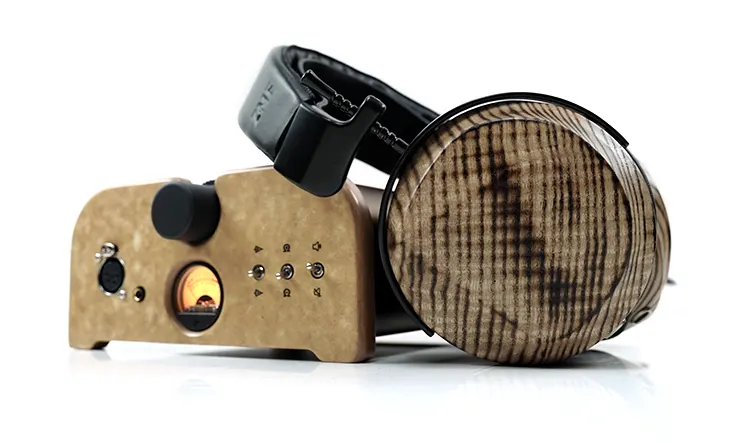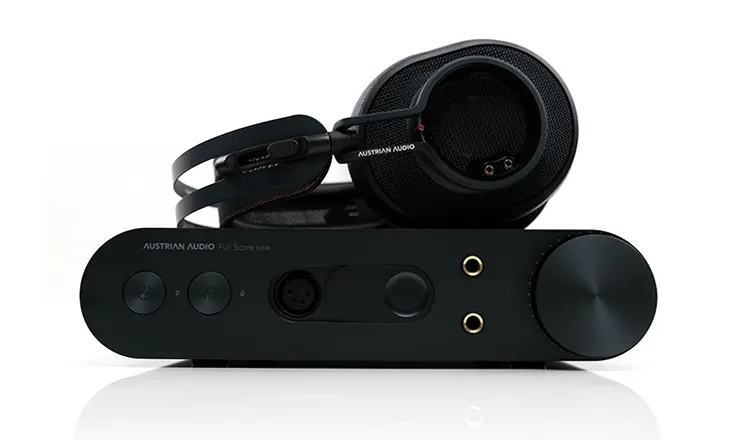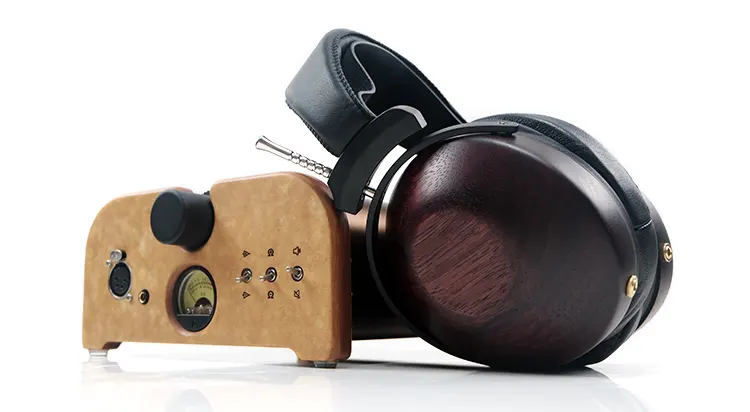Synergy
Power
The ZMF Headphones HOMAGE is rated at 2.2W into 32Ω, which drops to 475 mW into 150Ω, and 119 mW @600Ω with a maximum voltage input of 7 Vrms XLR and 8.45 Vrms via RCA.
The one missing benchmark is at 300Ω, where many of ZMF’s most popular headphones reside. For that, you get a maximum of 238mW on the RCA with an 8.45Vrms max input and 163mW via XLR on a 7Vrms input.
The lower XLR Vrms is due to it being dropped down slightly, to accommodate for the typical stronger input from DACs through XLR.
That is right on the money for the power handling rating of some high impedance dynamic drivers and true enough I did not have any specific issue driving the Atrium and Atrium Closed.
However, via an OTL amplifier such as the Feliks Audio EUFORIA evo I felt the same headphones delivered a more optimal performance in terms of holographic staging, timbre matching, and dynamic range.
Once you drop the impedance level of your paired gear the HOMAGE’s 0.7 Ω / 47 Ω switch selector has a more noticeable impact on the performance.
I felt the HOMAGE excelled with planar driver headphones and dynamic driver alternatives with a slightly lower impedance rating such as the Caldera Open/Closed or the 80Ω BOKEH.
IEMs do very well on the amp’s low impedance mode with a low gain setting. The relatively sensitive and easy-to-drive UM Multiverse Mentor rated at 22Ω and 114 dB @1kHz did not experience low volume channel imbalance issues with a nice black background and good dynamics at quieter listening levels.
Pairings
I felt the HOMAGE’s spacious presentation paired well with closed-back headphones and open-back alternatives offering good staging capability and low-end power.
Compared to the Topping DX9 PO, or the Gustard H26‘s equivalent, the HOMAGE has a bit more thrust from the low end without too much upper-bass bloom either. That level of low-end control is a good match for headphones such as the BOKEH, the Caldera Closed, and Dan Clark Audio’s E3.
All three had excellent weight combined with a good level of perceived space which I find essential for desktop closed-back pairings.
The DAC input is another factor in advisable pairings with the HOMAGE. I recommend avoiding a neutral DAC with headphones that have strong highs. This does not play quite as well with the HOMAGE’s tuning.
For example, the Homage sounded relatively smooth with excellent bass weight on the BOKEH. However, the neutral DX9 DAC lineout created a leaner and brighter tone through the upper mids and highs.
I found the better tonal balance with slightly smoother highs using the Cayin N7 smoother 1BIT lineout to the HOMAGE instead.
The DCA E3 also pairs better with the HOMAGE using a smoother richer-sounding DAC such as the Musician Audio Aquarius or the Ladder Schumann (and the N7). Both R-2R DACs brought a slightly denser tone to the upper mids and highs along with the impressive bass weight.
Select Comparisons
The following comparisons to the ZMF Headphones HOMAGE were completed using the Topping DX9 balanced lineout with an I²S input from a Cayin N7 and a direct balanced lineout from the Cayin N7.
Headphone pairings included the ZMF Headphones Caldera and the BOKEH with the UM Multiverse Mentor for IEM testing.
Gustard H26
The Gustard H26 was a recent launch by the company with our review coming out in mid-July of this year and is almost the same price as the HOMAGE.
Technical
Both amps are marketed as desktop headphone amplifiers though size-wise the Gustard is the bigger and heavier of the two.
I find the HOMAGE Richlite wood finish and overall boutique design a lot more eye-catching than the plainer black of the H26 aluminum chassis. However, I accept that many potential owners will see the streamlined housing and legible LED panels as equally attractive and perhaps more mainstream.
The H26 is also a discrete Class A preamp and headphone amplifier rather than an opamp-based Class AB and can output 12W balanced PO output power on a 32Ω load, much higher than the HOMAGE’s maximum 2.2W balanced PO rating.
The HOMAGE has no pre-amp output capability operating as a headphone amplifier only with a balanced input and SE output stage. The H26 also has an additional 6.35mm SE PO on the front panel which ZMF has left out on the HOMAGE.
Though lacking the H26’s LED display panel, the HOMAGE does have more user controls with a 3-stage gain switch and dual-level impedance selectors. The H26 only has a dual gain stage accessible through a multi-function dial operation.
I also find the H26’s algorithmic volume control to be somewhat weighted meaning any demanding headphone pushes the volume quite high, even on high gain though no headphone ever runs out of headroom.
It’s more on the back panel where you see the H26’s true worth with its ability to handle 2 balanced and 1 single-ended line-in as well as SE and balanced outputs for pre-amping.
Performance
The answer to which amplifier is better is going to depend on what you plug into it.
For example, the Caldera sounds much more playful with the HOMAGE, whereas the H26 is more serene and relaxed with a smoother delivery. This played a lot to the BOKEH strengths but it was a more even match with the Caldera.
Perhaps that is the one theme throughout and it’s the harmonic balance that gives the HOMAGE its more playful but slightly rawer tone, especially in the upper mids.
The HOMAGE does have more weight on the low end, at least with the DX9 lineout which is a fairly vibrant-sounding DAC. This is complemented by a stronger treble presence that creates a slightly higher level of harmonic dissonance on vocal and percussion timbre.
It’s not a huge thing but given how sweet and pristine the H26 timbre is through the same region with the same headphones it is noticeable.
So, you get the dynamics and contrast with the HOMAGE which can create a more vibrant and driven performance, and the smooth airy control from the H26 which is ideal for vocal performances.
However, I did say it depends on what you plug into it. For IEMs, for which both amps do very well, a smoother monitor such as the UM Multiverse Mentor which I felt was the equivalent to the Atrium inside your ear, paired better with the HOMAGE.
The Mentor needs more tonal contrast from its source or can sound overly chilled. On some tracks, the H26’s smooth controlled delivery sounded slightly lifeless whereas HOMAGE’s more impactful tuning and better depth brought in the ‘fun’ element even if the instrumental separation through the mids is not quite as good.
Austrian Audio Full Score One
I have yet to do a dedicated review of the $1499 Full Score One but it has been referenced in some detail in my Composer review earlier his year.
Technical
Like the HOMAGE, the Full Score One is also a desktop analog headphone amplifier with no preamp capability.
Thus it has a matching set of rear panel inputs, balanced and SE, XLR/RCA but no 4.4mm PO on the front panel. Instead, you have a 4-pin XLR and dual SE PO so less ‘IEM-friendly’ but with the benefit of being able to run two single-ended headphones at the same time.
Aesthetically, the Full Score One follows the low-profile mainstream Gustard formula with an all-black aluminum alloy shell.
However, its curved edging is more like the Topping DX9 and has no front display or VU feedback other than a pair of LED dot lights to indicate its TTT mode is turned on.
The Full Score One is not much bigger than the HOMAGE with a similar depth and slightly less height. It is wider and about 1kg heavier.
Arguably the Austrian Audio amp is a bit easier for stacking but it largely depends on what you want to stack on top as they are not huge. Better they are the stack units themselves.
The Full Score One is rated at 1.2W @32Ω for output power which is less than the HOMAGE but this can expand up to roughly 3W with a stronger Vrms input from a DAC or Preamp.
Just be aware that the Full Score One guideline also states that although it’s designed to be a low-noise amp loads below 10Ω are not recommended which might rule out a lot of low impedance IEMs or create possible impedance skew.
Performance
Neither amplifier has a problem driving the Caldera planar or the 80Ω dynamic BOKEH though I would not rush to hook them up to the Susvara Unveiled on that initial salvo.
They do offer different performances which might determine which one is right for you.
For example, the Caldera sounded tighter and punchier on the Full Score One, and of the two, I felt it had a little bit more resolution and dynamic range.
However, it’s a very neutral amplifier with midrange bias and staging quality more to the intimate side, perhaps slightly flatter in dimensionality compared to the HOMAGE.
The Caldera’s planar responds well to the control the Full Score One offers with some excellent vocal focus as the icing on the cake. I also found the treble just a little gentler on my ear, perhaps not as prominent or as sparkling as the HOMAGE.
I must add that the TTT mode on the Full Score One should remain on. Without this mode, the presentation sounds flatter and less distinct or as well separated, especially through the lower mids of the Caldera.
The HOMAGE takes a different direction. It’s weightier on the lows, slightly warmer also though the lower mids but not quite as punchy on the mid-bass.
What it has is depth and a more atmospheric staging quality. It sounds roomier, with a bit more sparkle on the highs but slightly thinner and more withdrawn on the vocal immediacy using both the BOKEH and the Caldera open.
The HOMAGE offers a generally more pleasing dynamic quality that better suits Caldera’s deep and ’emotional’ presentation. However, I also admit that Full Score One’s resolution and control taxes the driver more, especially through the midrange.
Cayin HA-2A
The Cayin HA-2A is also in the same price bracket and was launched in the Spring of 2024 with our review shortly after in June.
Technical
This is a solid-state (HOMAGE) versus an all-vintage NOS Ultralinear tube amplifier. A tube amp that is bigger dimensionally and much heavier at 10kg compared to just under 2 kg.
Rarely do you get a lightweight desktop tube amplifier due to the transformers inside but the HA-2A is relatively compact for an amp of this type.
Aesthetically, the HA-2A looks the business with a silver aluminum body, two functional VU on the front panel, input/output and impedance selectors, and both SE and balanced PO.
The HOMAGE has similar features with 4.4mm/XLR balanced outputs, a single VU, and impedance selectors. Both have matching balanced/SE rear panel inputs and no pre-amp capability.
Functionally, they differ in the lack of SE PO on the HOMAGE and only two impedance values instead of three with the HA-2A offering no gain or mute control.
The HA-2A amplifier is balanced-driven through Cayin’s in-house designed output transformer. However, the tube amplification circuit is a point-to-point welded pure Class A transformer-coupled single-ended design.
Where the HOMAGE outdoes the HA-2A is in raw power. At 2.2W into a 32Ω it can deliver more than the maximum 1W rating of the HA-2A’s 4-pin XLR output.
If you switch to 4.4mm this drops to a maximum of 300mW making it a suitable pairing for IEM users, a user group that the HOMAGE is also targeting.
Performance
This is probably the amp that comes closest to the HOMAGE’s target market. I can see the territory the HOMAGE is aiming for with the HA-2A delivering a nice smooth, euphonic sound with saturated notes, and sweet highs.
You can tell the HOMAGE is solid-state compared to the HA-2A in the slightly ‘quicker pace’ and drier timbre magnified by the control on the lows and a harder edge on the highs.
With the BOKEH, I could take either amplifier with both exhibiting some strengths in different areas. If you want the best bass control and a little more sub-bass power then the HOMAGE delivers but if you need more richness and warmth from your lows then the HA-2A does better.
To tell you the truth both offer great low-end performances in terms of overall weight so I would say the decider is the mids and highs performance of which the HA-2A sounds smoother and sweeter with the BOKEH and the Caldera open.
It’s a more languid pace than the HOMAGE, maybe not as much contrast tonally, but the euphonic quality makes for a very inviting listening experience. The HOMAGE is more neutral in weight and tonal coloration, perhaps even a shade harder-edged the higher you go. It can be more exciting but maybe not as forgiving.
The HOMAGE suits those who want more extension or want to pair a warmer-sounding set of headphones. I would pair neutral or clean-sounding headphones with the HA-2A when you want to take the edge off the highs and upper-mids.
My Verdict
The ZMF Headphones HOMAGE is a solid little amplifier with a relatively natural-to-neutral tuning and plenty of impedance and gain options that work well with a wide range of headphones and IEMs.
It impresses the most with its expansive staging qualities which I find especially attractive for closed-back headphone pairings.
True to ZMF’s heritage, it has this warm and cozy wood-finished vibe and generally quite a unique visual design. The fact this is not a huge and weighty amplifier will also make it appealing to those with more limited desktop or rack spacing.
Just make sure you get the DAC pairing right for your personal preference and you have a balanced output jack cable connection then you should be good to go with the HOMAGE.
ZMF Headphones HOMAGE Technical Specifications
- Frequency Response 10Hz-20kHz +/- 0.01 dB
- SINAD @ 1kHz, 4VRMS (XLR) 119 dB
- SINAD @ 1kHz, 50mV (XLR) 88 dB
- IMD SMPTE -95 dB
- Noise (20-20kHz) 2 μV
- Crosstalk @ 10kHz -82 dB
- SNR (20-20kHz) 126 dB
- Dynamic Range (AES17) 120 dB
- Channel Balance +/- 0.5 dB
- Max Continuous Power, 600 Ω 119 mW (8.45VRMS RCA / 7VRMS XLR)
- Max Continuous Power, 150 Ω 475 mW
- Max Continuous Power, 32 Ω 2.2W
Configuration
- Gain (3-Way) 1.0, 1.75x, 4.3x
- Output Impedance (2-Way Switch) 0.7 Ω Low / 47 Ω High
- Inputs RCA, XLR
- Outputs XLR, 4.4mm Pentaconn
- Power Supply 25W, Universal Input
- Potentiometer Alps 27mm






